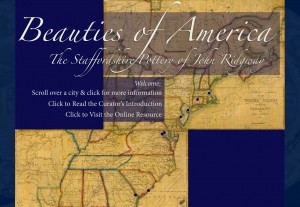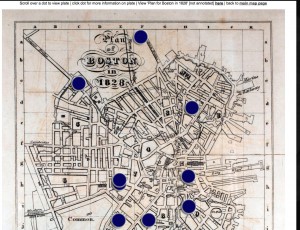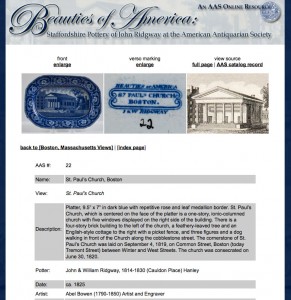 Of all the artifacts AAS has held on to over two centuries, the hardest one to explain is the collection of Staffordshire pottery. It’s not because it is a stretch really, but more because of the never-ending layers to unpack when the question comes up. How is it that a library that is devoted unwaveringly to early American history in print, manuscript and prints manages to have 324 pieces of these highly-coveted objects? And more importantly, how can you possibly make such items accessible?
Of all the artifacts AAS has held on to over two centuries, the hardest one to explain is the collection of Staffordshire pottery. It’s not because it is a stretch really, but more because of the never-ending layers to unpack when the question comes up. How is it that a library that is devoted unwaveringly to early American history in print, manuscript and prints manages to have 324 pieces of these highly-coveted objects? And more importantly, how can you possibly make such items accessible?
This first question is a relatively easy one: the donor, Emma DeForest Morse, bequeathed her collection to the Society in 1913, evidently feeling that the American historical scenery found on the faces of the plates would prove to be well-matched with AAS’s notable collections (and even more so with the impressive visual record found in the Graphic Arts holdings).

The second question is one which Ruth Ann Penka, AAS volunteer and curator of the newest online exhibit Beauties of America: The Staffordshire Pottery of John and William Ridgway, has been working on for years. It has been no easy task, since she is willing to do it only with gold-standard results. Penka wanted maps, illustrations, corresponding prints – and most importantly – documentation to follow the trail. So while on a Kinnicutt Fellowship in the United Kingdom, she found a treasure: the journal potter John Ridgway made during his journey to the United States in 1822 to accumulate views for his new series, The Beauties of America. Ridgway’s journal introduced Penka to some of the period’s cosmopolitan artists and allowed her to follow – through a Staffordshire potter’s own hand – the making of what would become an entire dinner service. This journey is preserved in her well-researched Curator’s introduction. Indeed, in Penka’s narrative and work the three big archival pieces of evidence – manuscript, books and graphics – coalesce. But they unite under an unusual medium: pottery. To this end (and in the hopes of providing the best surrogate for research possible) we have photographed the fronts and versos of the pieces, as well as the corresponding prints – painstakingly located by Penka – and we have made available her text-rich descriptions.  The site also features photographs of the original set-up of Penka’s talk, at which this material was first presented, complete with dynamic maps of the places Ridgway visited.
The site also features photographs of the original set-up of Penka’s talk, at which this material was first presented, complete with dynamic maps of the places Ridgway visited.
In 1821, Percy Bysshe Shelley wrote A Defense of Poetry, which just happens to be the same year Ridgway took his journey abroad (saying nothing of his comparable British roots). In Shelley’s Defense, he made candid his thoughts on beauty, goodness and the inexplicable connection between the two. He states that the poet’s functions are twofold:
One it creates new materials of knowledge, power, and pleasure; the other it engenders in the mind a desire to reproduce and arrange them according to a certain rhythm and order which may be called the beautiful and the good.
Shelley’s posthumously published essay, written in response to a piece calling for more reliance on sciences and less on arts, is one heightened by the poet seeing and making visible through his gift language ideas about the world. The poet’s purpose is of language favoring this impulse – towards a pattern, rhythm and order. Indeed, Penka’s project underscores (and preserves) this fact – that is, seeing the work of Ridgway as facilitator and pattern-finder, she brings together the beauty and elegance of his work and time by charting his course and showing his vision of the new nation. It seems only fitting that the project was originally destined to be on display at the 2010 CHAViC conference “History Prints: Fact and Fiction” where participants were able to see and engage with these fascinating pieces and the print culture surrounding them.
Seem a stretch to relate poetry to pottery?
Good. I was hoping you’d say that.
The lasting effect of this seemingly inoffensive piece of dishware is well-played in American poet Gwendolen Haste’s 1946 poem entitled “Dorchester Plate”. In the piece, she describes the problematic history represented on a plate’s face – a scene which ignores the grass darkened by death and the sweat in the voiceless mill. In fact, Haste seems to take issue with Shelley who felt that “poetry is a mirror which makes beautiful that which is distorted” whereas she concludes this Dorchester plate (itself a creation) is instead a “mirror of the unreal.” Overall, Haste’s poem bridges this gap and highlights a challenge of historic scenery – that being how the representation is played out (and for what audience).

I guess I cannot help myself: I see a certain cadence, arrangement – and yes, poetry – in cataloging and in this exhibit. Perhaps it’s because there is sense being made of items – and allowing caverns of human knowledge and experience to come within reach. The twenty-two plates featured in the exhibit are just a taste – only a small part of the Society’s collection. Beauties of America will be augmented this year and a visual catalog of 100 plates will be made available by the end of 2012. So we encourage you to engage with this new site – and feast your eyes on this dinner service.
